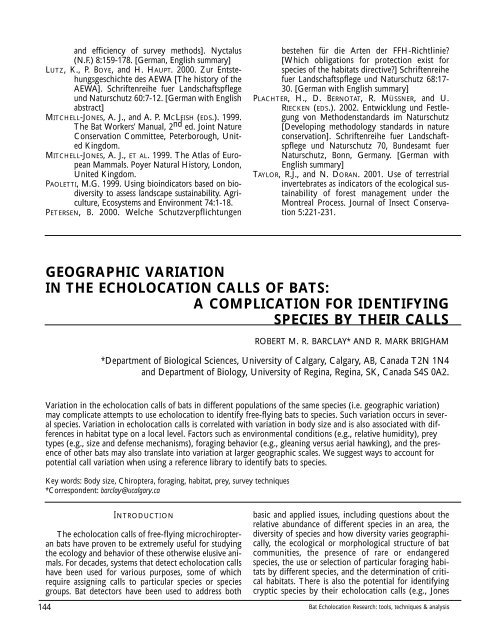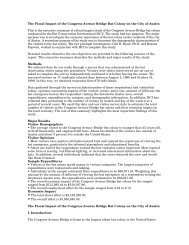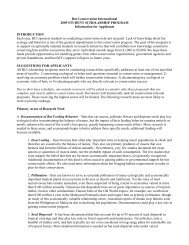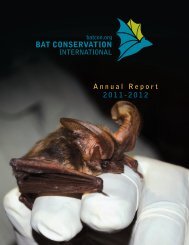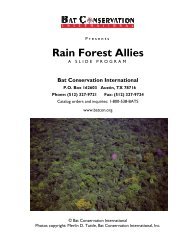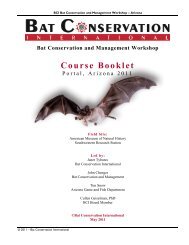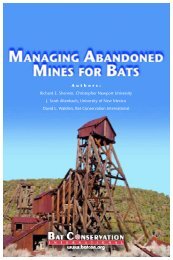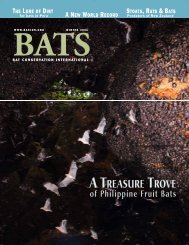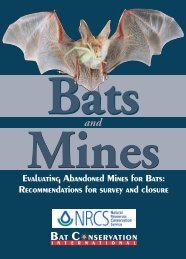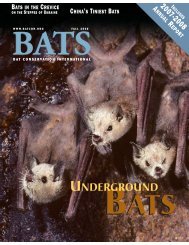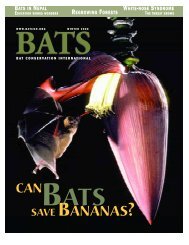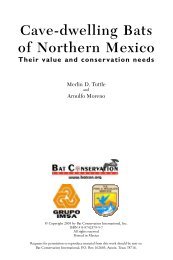Bat Echolocation Researc h - Bat Conservation International
Bat Echolocation Researc h - Bat Conservation International
Bat Echolocation Researc h - Bat Conservation International
Create successful ePaper yourself
Turn your PDF publications into a flip-book with our unique Google optimized e-Paper software.
and efficiency of survey methods]. Nyctalus<br />
(N.F.) 8:159-178. [German, English summary]<br />
LUTZ, K., P. BOYE, and H. HAUPT. 2000. Zur Entstehungsgeschichte<br />
des AEWA [The history of the<br />
AEWA]. Schriftenreihe fuer Landschaftspflege<br />
und Naturschutz 60:7-12. [German with English<br />
abstract]<br />
MITCHELL-JONES, A. J., and A. P. MCLEISH (EDS.). 1999.<br />
The <strong>Bat</strong> Workers’ Manual, 2 nd ed. Joint Nature<br />
<strong>Conservation</strong> Committee, Peterborough, United<br />
Kingdom.<br />
MITCHELL-JONES, A. J., ET AL. 1999. The Atlas of European<br />
Mammals. Poyer Natural History, London,<br />
United Kingdom.<br />
PAOLETTI, M.G. 1999. Using bioindicators based on biodiversity<br />
to assess landscape sustainability. Agriculture,<br />
Ecosystems and Environment 74:1-18.<br />
PETERSEN, B. 2000. Welche Schutzverpflichtungen<br />
bestehen für die Arten der FFH-Richtlinie?<br />
[Which obligations for protection exist for<br />
species of the habitats directive?] Schriftenreihe<br />
fuer Landschaftspflege und Naturschutz 68:17-<br />
30. [German with English summary]<br />
PLACHTER, H., D. BERNOTAT, R. MÜSSNER, and U.<br />
RIECKEN (EDS.). 2002. Entwicklung und Festlegung<br />
von Methodenstandards im Naturschutz<br />
[Developing methodology standards in nature<br />
conservation]. Schriftenreihe fuer Landschaftspflege<br />
und Naturschutz 70, Bundesamt fuer<br />
Naturschutz, Bonn, Germany. [German with<br />
English summary]<br />
TAYLOR, R.J., and N. DORAN. 2001. Use of terrestrial<br />
invertebrates as indicators of the ecological sustainability<br />
of forest management under the<br />
Montreal Process. Journal of Insect <strong>Conservation</strong><br />
5:221-231.<br />
GEOGRAPHIC VARIATION<br />
IN THE ECHOLOCATION CALLS OF BATS:<br />
A COMPLICATION FOR IDENTIFYING<br />
SPECIES BY THEIR CALLS<br />
ROBERT M. R. BARCLAY* AND R. MARK BRIGHAM<br />
*Department of Biological Sciences, University of Calgary, Calgary, AB, Canada T2N 1N4<br />
and Department of Biology, University of Regina, Regina, SK, Canada S4S 0A2.<br />
Variation in the echolocation calls of bats in different populations of the same species (i.e. geographic variation)<br />
may complicate attempts to use echolocation to identify free-flying bats to species. Such variation occurs in several<br />
species. Variation in echolocation calls is correlated with variation in body size and is also associated with differences<br />
in habitat type on a local level. Factors such as environmental conditions (e.g., relative humidity), prey<br />
types (e.g., size and defense mechanisms), foraging behavior (e.g., gleaning versus aerial hawking), and the presence<br />
of other bats may also translate into variation at larger geographic scales. We suggest ways to account for<br />
potential call variation when using a reference library to identify bats to species.<br />
Key words: Body size, Chiroptera, foraging, habitat, prey, survey techniques<br />
*Correspondent: barclay@ucalgary.ca<br />
144<br />
INTRODUCTION<br />
The echolocation calls of free-flying microchiropteran<br />
bats have proven to be extremely useful for studying<br />
the ecology and behavior of these otherwise elusive animals.<br />
For decades, systems that detect echolocation calls<br />
have been used for various purposes, some of which<br />
require assigning calls to particular species or species<br />
groups. <strong>Bat</strong> detectors have been used to address both<br />
basic and applied issues, including questions about the<br />
relative abundance of different species in an area, the<br />
diversity of species and how diversity varies geographically,<br />
the ecological or morphological structure of bat<br />
communities, the presence of rare or endangered<br />
species, the use or selection of particular foraging habitats<br />
by different species, and the determination of critical<br />
habitats. There is also the potential for identifying<br />
cryptic species by their echolocation calls (e.g., Jones<br />
<strong>Bat</strong> <strong>Echolocation</strong> <strong>Researc</strong>h: tools, techniques & analysis


